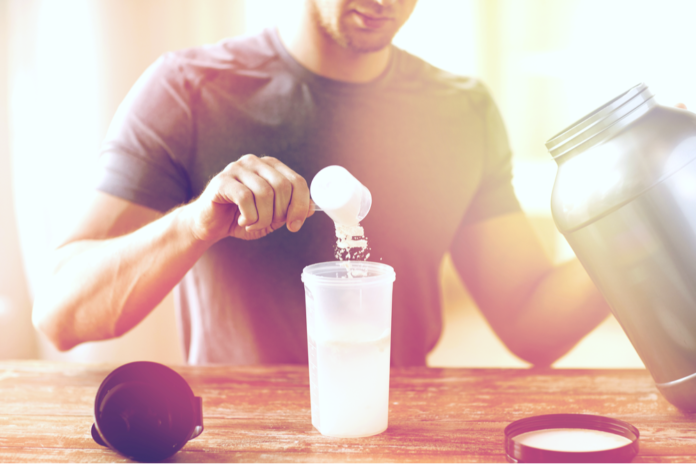Growing muscle mass and strength is tough work, requiring resistance training and optimal nutrition. While it is widely known that adequate protein and carbohydrates contribute to strength gains, much debate exists about nutrient timing. It is so controversial, that some question whether the notorious anabolic window even exists.
Discover all the details about this disputed metabolic window in this article!
What Is Anabolism?
Anabolism is the process of growth and repair. It occurs when small molecules grow into bigger, more complex ones. These molecules then form into new cells and tissues, as happens after working out.
This process opposes catabolism, which is the breakdown and release of molecules. While exercise mostly involves catabolic reactions, the period of time following training is largely anabolic. This time period induces various cellular processes that facilitate growing and repairing muscle tissue, which may be enhanced with proper dietary protein and carbohydrate intake.
What Is the Anabolic Window?
The anabolic window, also called the metabolic or anabolic protein window, refers to the short stretch of time after exercising. Muscles are trying to repair, recover, and grow in response to the wear and tear induced by training.
Falling under the umbrella of nutrient timing, proponents of the anabolic window claim that 30 to 60 minutes after exercise is the most important time to consume adequate protein and carbohydrates to maximize strength gains.
According to this theory, the quick consumption of protein and carbohydrates is critical for increasing protein synthesis, reducing muscle protein breakdown, and replenishing muscle tissue glycogen.
The Science Behind the Anabolic Window
Interestingly, the scientific jury is still out regarding this concept, although some research backs its claims.
To fully grasp the science, it is important to understand another interrelated concept known as net muscle protein balance (NBAL). This refers to the balance of muscle protein breakdown (MPB) and muscle protein synthesis (MPS). MPB increases after strength training, but less so than MPS, and the balance (NBAL) between these two processes ultimately determines muscle growth.
Furthermore, post-workout nutrition affects these reactions, where protein minimizes muscle protein breakdown and promotes muscle protein synthesis. While carbohydrate intake does not directly affect MPS, it inhibits MPB and supports glycogen resynthesis to provide fuel for subsequent movement.
Thus, it seems quite logical to immediately eat protein and carbohydrates to preserve and build muscle mass, which is essentially increasing NBAL. Only when NBAL leans toward less MPB and more MPS can muscles grow. Yet, opponents of the anabolic window theory suggest this is an oversimplification of the actual science.
Opposing Science
First of all, muscle mass growth depends on myofibrillar proteins, so muscle protein breakdown suppression would need to only target these proteins. Yet, science shows that MPB affects various types of proteins, including ones that have incurred damage from something like exercise.
Moreover, sufficiently degrading these proteins is essential to muscle growth, so minimizing MPB with post-workout nutrition could actually hinder full muscular recovery, repair, and, yes – growth. Plus, other factors such as genetics, age, hormone balance, training regimen, and other lifestyle habits affect how easily one grows muscle.
Secondly, although the concept of a narrow 30 to 60-minute anabolic window is a widely accepted belief, it’s not clear how this theory transpired nor is there hard evidence to support this timeframe. In fact, two studies revealed that consuming pre-workout protein within an hour before training produced the same muscle growth results as immediate post-workout protein consumption. The science showed that high-quality protein intake before resistance exercise was capable of sustaining amino acid delivery to muscles all the way into the post-exercise anabolic window.
Other studies and meta-analyses suggest there is not as strong of a connection between immediate protein intake after strength workouts and increased muscle growth or strength as once believed. One study examining the post-workout anabolic response determined the extent of the response was mostly related to muscle protein synthesis rather than muscle protein breakdown.
Additionally, a study from the late 1990’s determined that eating carbohydrate immediately after exercising is not any more beneficial than consuming it eight to 24 hours later! Thus, while the consumption of carbohydrates is important, the timing may not be so much.
Conversely, one study found that fasted exercise increases post-exercise muscle breakdown. This suggests it is important to eat soon after the completion of training to adequately replenish muscle fuel stores.
The Verdict: Is the Anabolic Window Open or Shut?
The research certainly suggests that the anabolic window of thirty to sixty minutes doesn’t really exist. But then why is it still so widely accepted and encouraged among the fitness community?
Well, science does show that the overall consumption of adequate protein and carbohydrates throughout the day is vital for proper muscle recovery and growth.
Perhaps, suggesting to immediately eat after a workout simply ensures that someone will intake some nutrition. Exercise is known to temporarily suppress appetite, but muscles remain hungry.
If someone waits too long to eat after a workout, they may be inclined to make poorer food choices. This is because their brain is desiring high-energy food that also digests quickly (think refined carbohydrates and fat), even though the muscles need high-quality protein and carbs to repair and grow properly.
The Bottom Line
All-in-all, it appears that the overall consumption of quality carbohydrate and protein sources throughout the day, whether eaten within 30 minutes or 3 hours before or after exercise, is most important. This helps guarantee the body has enough nutrients to fuel training and recover properly afterward.
While an immediate post-workout shake can help someone reach their total daily protein goal, it’s not necessary to zoom home to guzzle it. Unless one trains in a fasted state, rest easy and focus on properly cooling down via dynamic and static stretching after a workout.
References:
Barnett J. Is the Anabolic Window a Myth? Breaking Muscle. breakingmuscle.com/healthy-eating/is-the-anabolic-window-a-myth.
Cafferty L. The Truth About the Anabolic Window. Muscle & Strength. Updated June 13, 2020. www.muscleandstrength.com/articles/anabolic-window-truth.
Nunez K. Anabolic Window: What It Means and Whether It Exists. Healthline. Published June 22, 2020. www.healthline.com/health/fitness-exercise/anabolic-window.









